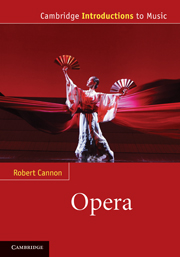Book contents
- Frontmatter
- Contents
- Tables
- Introduction
- Part I The seventeenth and eighteenth centuries
- Part II The nineteenth century
- Part III The twentieth and twenty-first centuries
- Appendix 1 Motifs from The Ring used in Chapter 10
- Appendix 2 The development of singing voices in opera
- Appendix 3 The development of lyric theatre alternatives to ‘opera’
- Appendix 4 Some major operas and artistic and political events of the twentieth century, 1899--2008
- Glossary of key terms
- Notes
- Bibliography
- Index
- Frontmatter
- Contents
- Tables
- Introduction
- Part I The seventeenth and eighteenth centuries
- Part II The nineteenth century
- Part III The twentieth and twenty-first centuries
- Appendix 1 Motifs from The Ring used in Chapter 10
- Appendix 2 The development of singing voices in opera
- Appendix 3 The development of lyric theatre alternatives to ‘opera’
- Appendix 4 Some major operas and artistic and political events of the twentieth century, 1899--2008
- Glossary of key terms
- Notes
- Bibliography
- Index
Summary
It demands as much effort on the listener's part as the other two corners of the triangle, this holy triangle of composer, performer and listener.
(Benjamin Britten, in Kildea, 2000: 261)The impulse to combine words, music and action has existed from the very beginning of drama. Indeed, musical drama mainly preceded the purely spoken, which immediately begs the question: where does opera begin? One simple but useful answer is at the point where people called their works ‘operas’ (or its equivalent). But to do this gives the impression of opera coming from nowhere, born fully formed, like Athena. Looking further back than the Florentine Camerata suggests the multifarious nature of musical theatre, the range of its potential and priorities.
- Type
- Chapter
- Information
- Opera , pp. 1 - 4Publisher: Cambridge University PressPrint publication year: 2012

